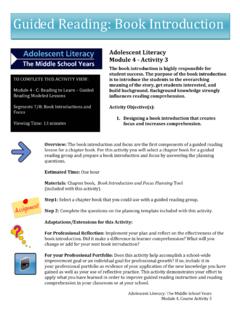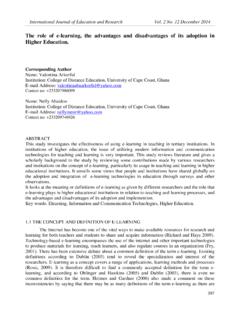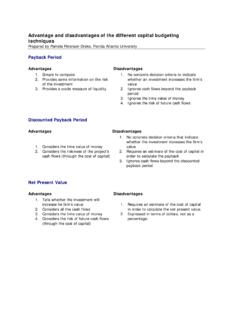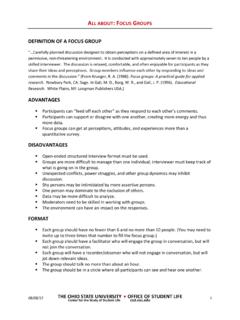Transcription of ADVANTAGES AND DISADVANTAGES OF …
1 ADVANTAGES AND DISADVANTAGES OF VARIOUSGRADE-LEVEL ORGANIZATIONSThe grade-level organization of the American school is characterized not by a single uniformpattern but by a variety of grade configurations. Each of these grade configurations has itsadvantages and DISADVANTAGES which have varying weights and influence in local districts as aconsequence of local circumstances. For schools districts seeking a definitive answer on thebest grade-level organization, no definitive answer exists. What exists are various lists of thepros and cons of each grade-level pattern which must be examined and evaluated in light of eachlocal district s and DisadvantagesIn 1978, the Jefferson County Public Schools in Kentucky conducted a review of theadvantages and DISADVANTAGES of the mast popular grade-level structures in use. The MineolaUnion Free School District also completed such a study in 1980.
2 In 1981, the SpencerportCentral School District undertook a similar review of various grade-level organizations andprepared a listing of the various ADVANTAGES and DISADVANTAGES . These ADVANTAGES anddisadvantages of various grade-level configurations identified by these three studies are listed asfollows. In reviewing the listings, it needs to be pointed out that an advantage identified by onedistrict may well be, given circumstances, a disadvantage for another. Any of the suggestedadvantages and DISADVANTAGES must be examined from the perspective of the local school district,its needs, circumstances, and 8-4 Plan (Grades K-S, 9-12). The 8-4 plan dominated other plans from the 1920 sthrough the 1950 s. The four-year high schools enjoyed national popularity for over 40 years,but began to be phased out in favor of the three-year high school, and then again reappeared withthe advent of the middle school movement.
3 This plan created large elementary schools (grades 1-8) and grouped pupils in their childhood years with early adolescents, causing educators to moveto other organization Pupils in an 8-4 grade level configuration would be kept in the elementary schoolenvironment longer than those pupils in most other grade-level patterns; thus, thechange from an elementary education program to a secondary education programwould come later when the pupil would be better prepared to cope with it. More emphasis could be given to the traditional so called fundamentals for studentsin the K-S school; the teacher would be with the pupil for the entire day or most of itand thus could provide better and more continuous instruction and guidance. Articulation between the elementary education program and secondary educationprogram could be easily achieved, since only one bridge would be required. Otherpatterns such as the 6-2-4 plan would require two bridges.
4 With pupils remaining, longer in contact with their elementary school and other elementary students, pressure from older students to grow up socially wouldoccur later. Home-school cooperation might be more easily attained, particularly at the elementary (K-8) level since parents would have many years to develop a relationship with and attachmentto the school, the staff, and the administration. Staff, administration and students could getto know each other very well. Since K-8 schools would probably be nearer the home of the pupil, transportation problemsand costs could conceivably be less for students in grades seven and eight when comparedto the costs of transporting seventh and eighth graders in other grade level patterns suchas the 6-3-3 or 6-2-4. The 8-4 pattern could afford an opportunity for a broader curriculum offering in the highschools than would such grade-level patterns as the 6-3-3 plan as a natural result ofdeveloping curriculum for four grades rather than The curriculum and program of activities for grades seven and eight in the 8-4 plan could benarrower than the curriculum in the middle grades of a 6-3-3, 6-2-4 or 5-3-4 pattern(without or with much less adequate libraries, shops, science rooms, physical educationfacilities, homemaking rooms, arts and crafts rooms, guidance provisions) and thus wouldprovide for the needs of these pupils much less adequately.
5 In addition, the opportunitiesof pupils in grades kindergarten to six might be seriously diminished by making provisionsfor the older pupils; to provide equivalent opportunity, both capital outlay and currentexpense costs would tend to be considerably greater. Exploratory courses, such as industrial arts, home economics and foreign languages would bemore costly if brought to the elementary school than if centralized in a junior high or middleschool. If an enriched program was attempted in the K-S schools, it might under certaincircumstances and in a number of schools, call for considerable duplication of special roomsand equipment which would not be used fully. Staffing costs in special areas for grade 6, 7and 8 would be higher than in a centralized model such as the 5-3-4 plan. Elementary teachers for grades seven and eight in the 8-4 plan might be difficult to findgiven existing tenure areas and certification requirements in New York State.
6 With .pupils forced to make a rapid adjustment from elementary to high school, the gapbetween elementary and secondary education might easily1 be so wide that it would beextremely difficult for students to bridge. Adequate guidance and necessary experience tofacilitate bridging the gap to secondary education might be difficult to provide. Early adolescents would be denied a school of their own and a broader curriculumoffering appropriate to their needs. In addition, the seventh and eighth grade socialscene may cause difficulty for the elementary school children. Elementary schools spanning K-S might become too large with students and teachersgetting lost in the crowd. Extracurricular activities, particularly interschool athletics, might suffer given theneed to address the requirements of all students grades K-S rather than a more limitedgrade span such as K-5, 6-8, 6 6 Plan (Grades K-6, 7-12).
7 This organizational plan has been used extensivelythroughout the United States and may still be found in many districts. Prior to the 1960 s, manydistricts began to recognize the need for the early adolescent to be housed in a separate awareness started the movement away from the 6-6 plan to the 6-3-3 plan. Many districtshave been reluctant to remove 7th and 8th grades because it would leave their high schoolsunderused, and would require two separate The secondary program in the 6-6 plan would provide an educational continuity for alonger period of time than any other of the grade-level configurations and a broaderrange of courses for students in the secondary school. A continuity of staff ( ,guidance can follow student for six years) would exist, and the entire secondary stafffor grades 6 to 12 could work together longer. The learning environment could bestandardized for the full six years of secondary school.
8 Earlier competition and a breakaway from the elementary school would be providedas compared to the 8-4 plan. More mature 12 to 14 year olds would have anopportunity to interact with older students, while immature sixth-graders would havean additional year in the elementary school as compared to the 5-3-4 plan or the 4-4-4 plan. The secondary school would be able to provide a subject-centered program withspecialists to teach particular courses. A wider base for staff flexibility would existthan with almost any other grade-level pattern with staff also more flexible forextracurricular activities. More electives could be possible for students. A teamapproach to solving educational problems would be possible; peer counseling andtutorial programs could be easily administered. Articulation between the elementary education program and secondary educationprogram would be more easily achieved, since only one bridge would be required thanin other patterns that require two bridges ( , the 6-2-4 plan).
9 The 6-6 plan is congruent with New York State s teacher training and teachercertification requirements and the State Education Department regulations which arebased upon a K-6, 7-12 This grade structure would force an earlier break from the elementary school than the8-4 plan and would create larger secondary schools than in other grade levelpatterns. Pupils between 11 and 14 years of age might be pressured to place their childhoodbehind them as a result of constant interaction between young adults and earlyadolescents. The 6-6 plan almost mandates a subject-centered program for the 6 years ofsecondary school. Teachers would be more subject-matter than child-oriented, andstudents would have little opportunity for dose identification with a would be required and could mean decreased flexibility ofteachers to explore a variety of subject areas. Seventh and eighth graders could be short-changed on extracurricular activities sincethe focus might well be on students in grades 9 12.
10 There could also be lesspersonal attention to seventh and eighth grade students by guidance and othersupportive staff than to students in grades 6-3 3 Plan (Grades K-6, 7-9. 10-12). By the 1960 s, this plan had become by far themost popular, succeeding the 8-4 plan. It emerged as a result of educators recognition of thespecial needs of the early adolescent. The plan successfully existed in many districts for severalyears until more recent research studies revealed two major shortcomings: (1) ninth graders weremore like the 10th, 11th, and 12th graders and (2) the junior high schools were becoming morelike high schools. These findings, in part, caused the demise of the junior high and the emergenceof the middle school The long stay in one elementary school compared to the 5-3 4 plan or the 4-4-4plan would facilitate better relationships for pupils, staff and parents and wouldmaintain a neighborhood school concept.












